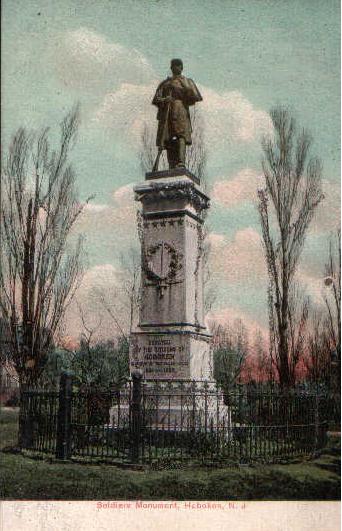 |
 A Short History of Hoboken
A Short History of Hoboken
1609-1784
By Leonard A. Luizzi
The year 2005 marks the 150th anniversary of Hoboken's incorporation as a city. However the history of Hoboken goes back much further than 1855. On October 2, 1609, Henry Hudson anchored his ship, the Half Moon, in what is now Weehawken Cove. First Mate Robert Juet made an entry in the ship's log: "We saw a good piece of ground... that looked of the color of white green." We know that he was looking at what is now known as Castle Point, because that's the only white-green rock formation on the Hudson. Thus the history of Hoboken begins!
In the first recorded land deed, the Indian owners turned the area over to the "Director and Council of New Netherlands." The deed was dated July 12, 1630, and referred to the "Island of "Hobocan Hacklingh". The area was now owned by the Dutch West India Company, and was going to be settled by Europeans, with Michael Pauw, Burger master of Amsterdam, as agent.
The Dutch name for Hoboken was "Hoebuck", which means "high bluff, presumably referring to the elevation now known as Castle Point. The Lenape Tribe, a branch of the Delawares, who settled the area near modern day Hoboken, called the land "Hobocan Hacklingh", which means "Land of the Tobacco Pipe". It is believed that the Lenapes made their pipes from soapstone found at Castle Point. Note that there is another Hoboken in Europe. It's a city in Belgium on the Sheldt River, but historians have not been able to find any connection between these two like-named cities.
The first settler of Hoboken was Hendrick Van Vorst, a member of the Van Vorst family, which settled in what is now Jersey City. Van Vorst farmed the land, but didn't actually live there. After Van Vorst's death, the farm was leased to Aret Teunissen Van Putten, who built Hoboken's first house. He also built a small brew house, which has the distinction of being the very first brewery in America. In 1643, there was an Indian uprising, during which Van Putten was killed and his house was burned down. But, for whatever reason, the brew house was left intact.
In 1663, Nicholas Varleth acquired a land grant from Dutch Governor Peter Stuyvesant. Varleth, had married Stuyvesant's widowed sister, Anna. Her first husband was Samuel Bayard, and Hoboken eventually passed to the Bayard heirs.
By the time of the American Revolutionary War, the estate was in the hands of Anna's grandson, William Bayard. He had a fine mansion on Castle Point, with beautiful gardens, fine orchards, and rolling farm land. There was also good fishing for shad in the Hudson River, and there were plenty of good oyster beds.
Bayard spent summers entertaining at his farm, including, in 1775, the delegates from Massachusetts to the Continental Congress. They probably felt right at home, since Bayard was a known patriot. However, that all changed in 1776, after Washington's disastrous defeat in New York City, resulting in the British capture and occupation of the city. Bayard decided that the American cause was a losing one, and went over to the British side, becoming a Colonel in the King's Army.
In 1778, "Light Horse" Harry Lee raided Bayard's farm, carrying off most of the cattle. Later in 1780, a party of Patriots burnt all the buildings on the farm. The New York Gazette of August 28, 1780, had this news item: "The Rebels on Saturday burnt Col. William Bayard's new home and barn, on the north end of Hobuck, and destroyed all the forage and timber."
After the Revolutionary War, Bayard's estate was confiscated and sold at public auction in 1784. The "Island of Hoboken" was then purchased by Colonel John Stevens, Treasurer of the State of New Jersey, for $90,000. The Steven's name is still associated with the City of Hoboken 220 years later.

|
|
 |